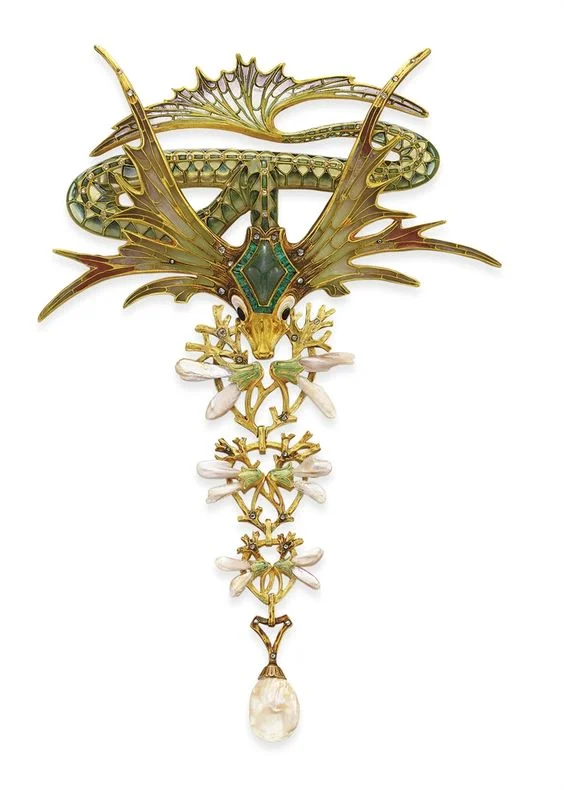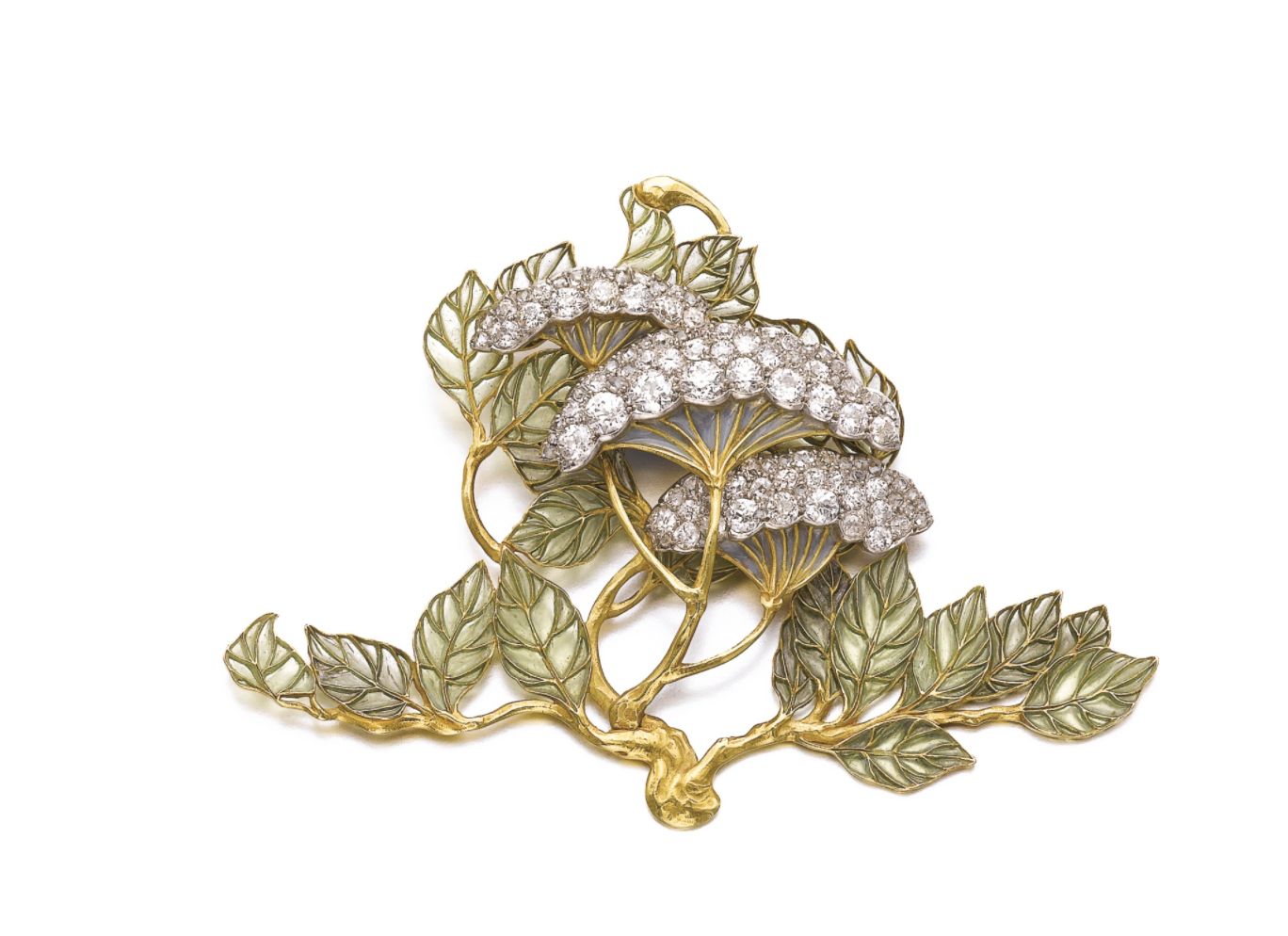The Rarity and Beauty of Art Nouveau Jewellery
“The beauty found in the finest pieces of Art Nouveau jewellery may be likened to that found in the paintings of Renoir, Seurat, or Gauguin. Such pieces are truly works of art, masterpieces of design. They are not merely items of adornment, but are pieces that move the beholder because of a distinctive quality that goes much deeper than merely being pretty.”
The Art Nouveau (or new art) movement was developed partly in reaction against the industrial revolution during the later half of the 19th century, in Europe and America and partly against the sterile resuscitation of the Louis the 16th Style, a taste associated with an aristocratic and moneyed elite. Mass production, polluted cities and a more materialistic society, left many artists drained of creative inspirations and energy. Emerging from the conventions and restrictions of late Victorian era, the movement’s philosophy of freedom, emphasis on femininity and embracing nature was a great contrast to the stoicism and strict adherence to rules of society that defined European life during that time. Such distinctive and dominant themes of the Art Nouveau movement hence became a welcome radical change and a form of emotional release for some designers and artists.
The was name derived from an exhibition, “La Maison de l’Art Nouveau”, in December of 1895 in Paris. Organised by Siegfried Bing, a German art dealer in Paris, also known for having introduced Japanese Art to theWest, his gallery was dedicated to works by artists of what would become known as the Art Nouveau style. The show had a deep impact in the community and created much discussion. Among those who participated were August Rodin, Louis Comfort Tiffany, Emile Galle and Rene Lalique.
Inextricably woven into the story of Art Nouveau is that of the symbolist movement, which had dominated Parisian literature and painting in the preceding decades. It’s proponents rejected materialism and naturalism and made freedom of the imagination supreme. Jean Moreas, a Greek-French Poet, declared In his manifesto of symbolism in 1886, that art should concern itself with ideas, emotion and beauty. The artistic realization of symbolist theory resulted in works full of mystery, suggestion and illusion. Often depicted are exotic creatures of the imagination, women with peacock feather tails or whose bodies metamorphose into griffins, sphinx or vast birds. The artists wished to present their ideas through the use of symbols that appealed to the emotions rather than the intellect.
While the Art Nouveau style may be found in drawings, architecture and furniture, there was a more profound influence on jewellery. More than any other medium, jewellery permitted a wide variety of styles, shapes, forms and materials, easily capturing the very essence of Art Nouveau. Featuring free curving lines, flowers and leaves seem to move and twist, birds and insects, mythical creatures flying or about to take flight. It was never a passive or static creation, always flowing and in harmony with nature. The finest pieces of Art Nouveau Jewellery will bealive with emotional appeal and transmitting a sense of beauty not seen in any other type of jewellery.
Prior to Art Nouveau, the female form had rarely been portrayed, but all the leading exponents of the period produced interesting interpretations of femininity. Often unclothed, with long sensual hair swirling, with a subdued or wistful looking face. For the Art Nouveau artist, the female form represented harmony in life and art, but also reflected the hard-won emancipation and a women’s developing role in society. Women’s suffrage (the first wave of feminism) happened during this period and perhaps for these feminist, wearing such taboo styles was their way of making a statement about their need for change. The creations of top Art Nouveau jewellers such as Henri Vever, Georges Fouquet and Rene’ Lalique often combined female heads and figures with foliage, butterflies and exotic animals.
Natural pearl, gem set and diamond brooch/ pendant, Georges Fouquet, Late 19th Century
Designed as a lady with flowing hair and headdress, the face and hair composed of carved chalcedony, applied with plique-à-jour enamel and highlighted with cabochon and circular-cut rubies, circular-cut and rose diamonds, suspending a natural pearl, pendant loop, signed G. Fouquet and numbered, French assay marks, case, Fouquet.
Estimate: GBP 12,000 — 15,000 LOT SOLD December 2012 . 97,250 GBP (Hammer Price with Buyer's Premium). Photo courtesy of Sotheby's.
Insects became fantasy creatures, sometimes grotesque but more often exceptionally beautiful. The butterfly and the dragonfly were the most common insect motifs and were used in endless variations. The entwined, writhing serpent, the symbol of life, eternity and sexuality, were best captured by the artist-jewellers Rene Lalique, and Georges Fouquet.
The flamboyant peacock was a recurrent motif depicting the voluptuous, rich plumage in densely coloured enamels. Along with the majestic peacock, emerged the stately white swan and other bird motifs, including swooping swallows, cockerels, as well as eerie night creatures such as the owl and the bat. The imagery of fantasy was best illustrated by the mermaid, dragons, chimeras and griffins.
An 18 Karat Gold, Molded Glass and Enamel Ring, René Lalique, France
Designed as a greenish blue glass face of Medusa, with blue and green enamel scales applied to the snake, gross weight approximately 10 dwts, size 8, signed Lalique, with French maker's mark; circa 1900.
Estimate: USD 15,000 — 20,000 LOT SOLD SEPTEMBER 2016. USD 322,000 (Hammer Price with Buyer's Premium) - Photo Courtesy of Sotheby's
An Art Nouveau Enamel and Pearl Corsage Ornament by George Fouquet
Photo Courtesy of Christie's
Miniature landscape scenes often form the backdrop to these motifs, and would contribute to the overall composition and emotion of the piece, whether it be a blue-grey melancholy sky or bright, beaming sun or gold rays. Often scenes would portray a ripping lake, a floral garden or a dense, dark forest. The changing of the seasons or the cycles of the year was also a prominent theme, capturing the icy white of a stark winter or the russets and golds of the fall. Moreover, the play-of-light and colour combination would contribute to the overall scene of a stunning Art Nouveau jewel.
Along with the unique asthetics of Art Nouveau, new and never before used materials were experimented with in the making of Art Nouveau jewellery. Animal horn, ivory were baroque pearls, chosen for their artistic merit and not their intrinsic value. Semi-precious gemstones, which were rarely used in jewellery at that time, were valued for their colours which could compliment the design, corals, lapis lazuli, jade and also opals -- a popular gemstone because of its delicate shifting colours that appears to come alive. Whereas diamonds were considered ‘cold’ and used only as sides stones to enhance, the texture these new materials and techniques.
Enamel was the most important material used in an Art Nouveau jewellery piece. The plique-a-jourtechnique was undoubtedly the most advanced and important form of the enamelling processes as well as the most difficult and delicate. In traditional enameling, a thin coat of powdered glass is applied to the surface of the metal, constructed in cells, like cloisonné, and then fired. While in plique-a-jour enameling, open spaces are filled with translucent colours; the enamel adhering to the cell walls. After firing, the backing that supports the enamel is removed and, when held up to light, the effect is similar to miniature stained glass windows. The resulting effect of different colours within the same cell is achieved either by varying the enamel amount applied or by layering one colour over another, much like a three dimensional painting.
Enamel and diamond brooch, 'Hydrangea Petiolaris', René Lalique, circa 1900
Of floral and foliate design, the flowers set with circular-cut, cushion-shaped and rose diamonds, the leaves applied with light green plique-à-jour enamel, signed Lalique, brooch fitting detachable.
Enamel and diamond brooch, 'Hydrangea Petiolaris', René Lalique, circa 1900
Estimate: CHF 79,000 — 118,000 LOT SOLD November 2016. 212,500 CHF (Hammer Price with Buyer's Premium)
Photo Courtesy of Sotheby's
While Art Nouveau was loved and enthralled by some, it was also scorned and ridiculed by others. Cartier, who were already well renowned Parisian jewellers by that time, never embraced the Art Nouveau movement. They instead produced pieces for the aristocrats and entrepreneurs, who preferred the pomp and splendors of diamond-set, 18th century revival styles, what is now known as “Belle Epoque” (or beautiful period) jewellery. Delicate, romantic, bows of all shapes, laces and flower and vines called “garland style” jewellery pieces, made with diamonds and precious stones. The “Belle Epoque” style began and ended at almost the same time as Art Nouveau. By around 1915, Art Nouveau was no longer fashionable and was succeeded by the Art Deco style, which in comparison was geometric and streamlined.
Many of the larger, more important Art Nouveau pieces made for the stage, or for exhibition purposes to showcase the jewellers skill, are now considered great masterpieces and can rarely be found in the jewellery market. Many are acquired by museums (most notably the Calouste Gulbenkian Museum in Lisbon) or have stayed in private collections. When they do appear at auction, they continue to exceed the auction estimates and have generally increased in value by around 30-40% in the last 10-15 years.
The number of collectors of Art Nouveau jewellery are slowly growing, and with an ever diminishing supply in the market, many are willing to pay a high premium for a piece of Art Nouveau jewellery, especially those with their fragile enamels in good condition. Although some have tried, these pieces absolutely cannot be replicated to the high standards of craftsmanship and design set by the French jewellers of the period. Some of the most beautiful pieces may not be wearable jewellery but collectors are happy to have them framed or displayed, like a piece of art or sculpture, and to feel emotionally fulfilled just to behold it’s allure and technical artistry, unlike any other jewellery style.




